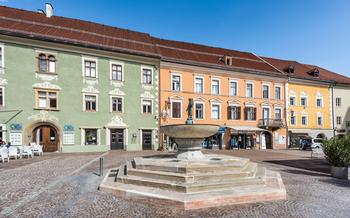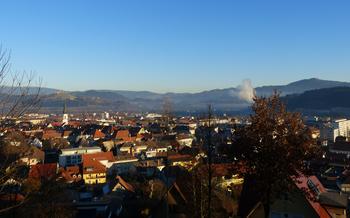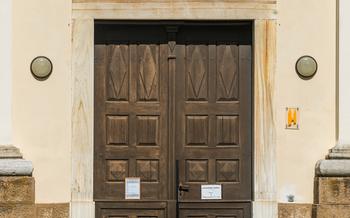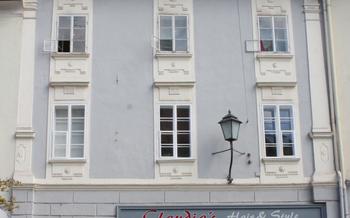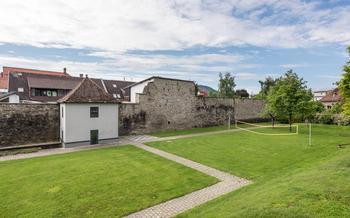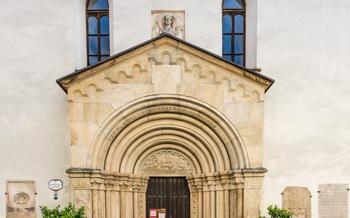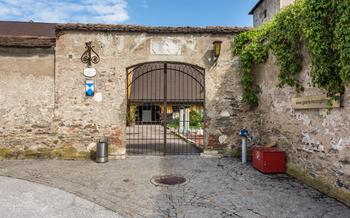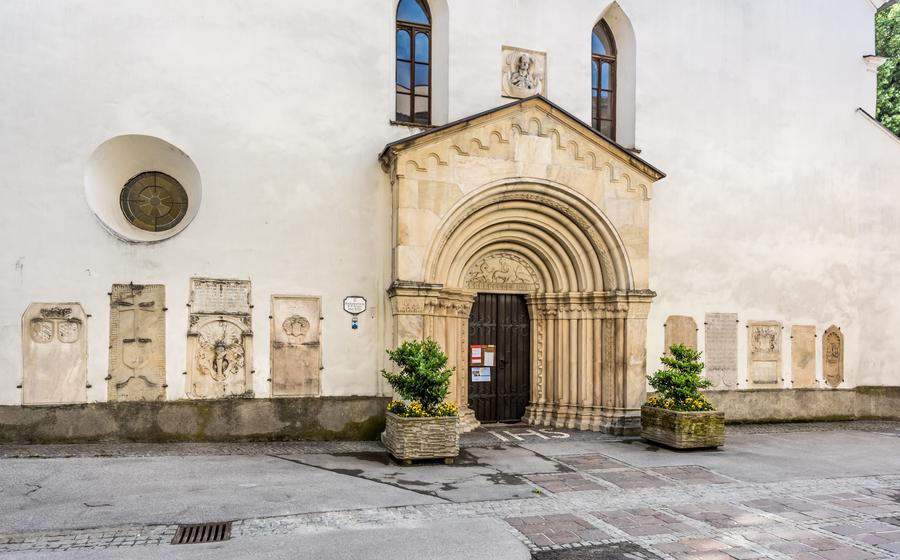
Benedictine Monastery of St. Paul
- Benedictine Monastery of St. Paul:
- Guided Tours
- Self-Guided Tours
- Museum of the Benedictine Monastery:
- St. Paul's Abbey Church:
- Monastery Library:
- Monastery Gardens:
- Pilgrimage Route:
- Events and Festivals
- Nearby Attractions
- Food and Drink
- Family-Friendly Activities
- Insider Tips for a Memorable Visit:
Benedictine Monastery of St. Paul:
The Benedictine Monastery of St. Paul, nestled in the heart of Sankt Veit an der Glan, Austria, stands as a testament to the enduring power of faith and architectural brilliance. Founded in the 11th century, the monastery has weathered the storms of time, undergoing numerous expansions and renovations, each leaving its unique mark on the complex's rich history.
As you approach the monastery, its imposing facade, adorned with intricate carvings and statues, hints at the grandeur that awaits within. Step through the grand entrance and be transported back in time as you wander through the cloisters, with their serene arches and peaceful gardens. The monastery church, a masterpiece of Romanesque architecture, captivates with its soaring columns, vaulted ceilings, and exquisite frescoes that depict biblical scenes.
The monastery's library is a treasure trove of knowledge, housing a vast collection of rare books and manuscripts. Here, scholars and researchers can delve into the depths of history, philosophy, and theology, surrounded by the hushed reverence of the centuries-old walls.
Guided Tours
Guided tours of the Benedictine Monastery of St. Paul are an excellent way to learn about its history, architecture, and cultural significance. Tours are available in several languages, including English, German, and Italian, and are led by knowledgeable and experienced guides.
Tours typically last around one hour and cover the main highlights of the monastery, including the church, the library, and the museum. Visitors will learn about the founding of the monastery in the 11th century, its role as a center of learning and culture throughout the Middle Ages, and its subsequent history as a Benedictine abbey.
The cost of a guided tour is typically around €10 per person, and reservations can be made in advance online or by phone. It's advisable to book a tour in advance, especially during peak tourist season, to avoid disappointment.
During a guided tour, visitors will have the opportunity to see some of the monastery's most impressive features, such as the stunning frescoes in the church, the beautifully carved wooden choir stalls, and the vast collection of rare books and manuscripts in the library. Guides will provide insights into the monastery's history, its religious significance, and its role in the local community.
Whether you are a history buff, an architecture enthusiast, or simply someone who appreciates beautiful and serene places, a guided tour of the Benedictine Monastery of St. Paul is an enriching and memorable experience.
Self-Guided Tours
For those who prefer to explore at their own pace, the Benedictine Monastery of St. Paul offers self-guided tours. Visitors can purchase a map and guidebook from the monastery shop, which provides detailed information about the history, architecture, and highlights of the complex.
A suggested itinerary for a self-guided tour might include:
- Start in the monastery church, admiring its stunning frescoes, stained glass windows, and intricate carvings.
- Continue to the library, where you can marvel at the collection of rare books and manuscripts.
- Visit the museum to learn about the history of the monastery and its role in the community.
- Explore the monastery gardens, taking in the peaceful atmosphere and admiring the variety of plants and flowers.
- Conclude your tour in the monastery shop, where you can purchase souvenirs and gifts related to the monastery.
When exploring the monastery independently, visitors are encouraged to take their time and savor the tranquil atmosphere. Photography and videography are permitted, but visitors are asked to be respectful of the religious nature of the site.
Museum of the Benedictine Monastery:
The Museum of the Benedictine Monastery in Sankt Paul, Austria, offers a fascinating glimpse into the history and cultural heritage of the monastery. The museum is located within the monastery complex and features a variety of exhibits and artifacts that showcase the rich traditions and contributions of the Benedictine monks.
The history of the monastery is presented through interactive displays, historical documents, and multimedia presentations. Visitors can learn about the founding of the monastery in the 11th century, its role as a center of learning and spirituality, and its contributions to the arts and sciences.
The museum also houses a collection of religious artifacts, including vestments, chalices, and other objects used in liturgical ceremonies. These items provide insight into the spiritual life of the monks and the development of religious practices within the monastery.
One of the highlights of the museum is the collection of medieval manuscripts and books. The monastery's scriptorium was a renowned center of learning and produced a wealth of illuminated manuscripts, many of which are now housed in the museum. Visitors can admire the intricate artwork and calligraphy that adorn these precious volumes.
The Museum of the Benedictine Monastery is open to the public and offers guided tours for visitors who want to learn more about the history and cultural significance of the monastery. The museum is a valuable resource for anyone interested in the history of monasticism, medieval art, or the cultural heritage of Austria.
St. Paul's Abbey Church:
The St. Paul's Abbey Church, also known as the Stiftskirche St. Paul, is the centerpiece of the Benedictine Monastery of St. Paul. It is a magnificent example of Romanesque architecture, with its origins dating back to the 12th century. The church's exterior is characterized by its sturdy walls, rounded arches, and intricate carvings. The interior of the church is equally impressive, with its soaring vaulted ceilings, elegant columns, and ornate frescoes.
One of the highlights of the church is its collection of stained glass windows, which depict scenes from the Bible and the lives of the saints. The windows date from different periods, and their vibrant colors and intricate designs add to the beauty and grandeur of the church.
The church is also home to a number of notable works of art, including sculptures, paintings, and tapestries. Among the most famous is the "Madonna of St. Paul," a 15th-century wooden sculpture that is considered one of the finest examples of Gothic art in Austria.
The St. Paul's Abbey Church is a living testament to the faith and devotion of the Benedictine monks who have called this monastery home for centuries. It is a place of worship, pilgrimage, and inspiration, and it continues to draw visitors from all over the world who come to admire its beauty and experience its spiritual power.
Monastery Library:
The Benedictine Monastery of St. Paul houses a remarkable library, renowned for its impressive collection of rare books and manuscripts. Established in the 12th century, the library has been meticulously curated over the centuries, amassing a wealth of knowledge and historical significance.
The library's collection boasts over 100,000 volumes, including medieval manuscripts, incunabula (books printed before 1501), and rare editions of theological, philosophical, and scientific works. Among the highlights are the "St. Paul Codex," an 8th-century manuscript containing biblical texts, and the "Carmina Burana," a collection of medieval poems and songs.
Guided tours of the library are available, providing visitors with an in-depth look into the history and significance of the collection. Visitors can admire the intricate illuminations and calligraphy that adorn the manuscripts, and learn about the role of the library in preserving and disseminating knowledge throughout the centuries.
For scholars and researchers, the library offers access to a wealth of resources. Reading rooms and research facilities are available, and the library staff is on hand to assist with inquiries and provide guidance. The library's collection is a valuable resource for those studying medieval history, theology, philosophy, and the history of the book.
Monastery Gardens:
Amidst the historic walls of the Benedictine Monastery of St. Paul, a tranquil oasis awaits visitors in the form of the monastery gardens. Lovingly tended by the monks over centuries, these gardens offer a serene sanctuary for contemplation and a vibrant display of nature's beauty.
Strolling through the gardens, visitors are greeted by a symphony of colors and fragrances. meticulously laid out flower beds burst with vibrant hues, while the air is filled with the sweet scent of roses, lavender, and jasmine. The gardens are a haven for a diverse array of flora, from delicate alpine flowers to towering trees that have stood sentinel for generations.
For those seeking a moment of tranquility, secluded benches nestled amidst the greenery invite visitors to pause and soak in the peaceful atmosphere. The gentle murmur of a nearby fountain adds to the serene ambiance, creating a space where one can truly escape the hustle and bustle of everyday life.
Guided tours of the monastery gardens offer visitors a deeper insight into the history, design, and symbolism behind these sacred spaces. Knowledgeable guides share fascinating stories about the plants and their medicinal or spiritual significance, making the tour both educational and inspiring.
Whether exploring the gardens independently or as part of a guided tour, visitors are sure to find solace, beauty, and a renewed appreciation for nature's wonders within the monastery gardens of St. Paul.
Pilgrimage Route:
The Benedictine Monastery of St. Paul has been a significant pilgrimage site for centuries, attracting devout travelers from across Europe. The pilgrimage route to St. Paul's Monastery, known as the "St. Paul's Pilgrimage Route," is a well-established path that leads pilgrims on a spiritual journey through the picturesque landscapes of Carinthia.
The route traditionally begins in the town of Klagenfurt, the capital of Carinthia, and winds its way through charming villages, rolling hills, and lush forests before reaching its destination at the monastery. Along the way, pilgrims can visit numerous churches, chapels, and wayside shrines, each with its own unique history and significance.
The route is well-marked and maintained, making it accessible to pilgrims of all ages and abilities. There are various accommodation options available along the way, from traditional guesthouses to modern hotels, catering to the needs of different pilgrims.
Whether you are a devout Christian seeking spiritual enlightenment or simply an adventurous traveler looking for a unique experience, the St. Paul's Pilgrimage Route offers a rewarding journey that combines history, nature, and spirituality in a truly unforgettable way.
Events and Festivals
Throughout the year, the Benedictine Monastery of St. Paul hosts a variety of events and festivals that celebrate its rich history, culture, and traditions. These events offer a unique opportunity for visitors to experience the monastery in a different light and immerse themselves in its vibrant community.
One of the most popular events is the annual Christmas Market, held in the monastery's idyllic courtyard. The market features stalls selling traditional Austrian Christmas decorations, handmade crafts, and delicious food and drinks. Visitors can enjoy live music, choirs singing carols, and the warm glow of Christmas lights illuminating the monastery grounds.
During Easter, the monastery hosts special celebrations and processions that commemorate the life and resurrection of Jesus Christ. These events include solemn masses, candlelight processions, and festive concerts. Visitors can witness the monastery's beautiful altars and decorations adorned with Easter lilies and colorful eggs.
To celebrate the harvest season, the monastery organizes an annual Harvest Festival and Wine Tasting Event. Visitors can sample local wines and culinary delights from the region, while enjoying live music and entertainment. The festival also features demonstrations of traditional crafts and activities for children.
These are just a few of the many events and festivals held at the Benedictine Monastery of St. Paul. By participating in these events, visitors can gain a deeper understanding of the monastery's history, traditions, and the vibrant community that keeps its spirit alive.
Nearby Attractions
Beyond the walls of the Benedictine Monastery of St. Paul, the surrounding region offers a wealth of attractions that invite further exploration. History buffs can delve into the past at the nearby Hochosterwitz Castle, a magnificent fortress perched on a rocky outcrop, showcasing stunning views and a rich history dating back to the 9th century.
Nature enthusiasts will find solace in the picturesque Lavanttal Valley, renowned for its idyllic landscapes, lush forests, and meandering rivers. Hiking trails of varying difficulty levels crisscross the valley, promising breathtaking panoramas and encounters with local flora and fauna.
For a touch of contemporary culture, the Carinthian Museum of Modern Art in Klagenfurt, the capital of Carinthia, awaits with an impressive collection of 20th-century and contemporary artworks, including paintings, sculptures, and installations.
Day trips from Sankt Veit an der Glan offer even more opportunities for exploration. The charming city of Graz, with its well-preserved medieval center and UNESCO World Heritage-listed Old Town, is a must-visit for history and architecture enthusiasts.
Venture further into the heart of Carinthia to discover the Nockberge National Park, a stunning alpine landscape renowned for its pristine lakes, lush forests, and diverse wildlife. Hiking, biking, and scenic drives through the park offer unforgettable experiences amidst breathtaking natural beauty.
Food and Drink
Sankt Veit an der Glan offers a delightful culinary experience, blending traditional Austrian cuisine with modern culinary trends. Indulge in hearty and flavorful dishes that showcase the region's fresh produce and local ingredients. Sample the iconic Kärntner Kasnudln, delicate pasta pockets filled with a savory mixture of cheese, herbs, and potatoes. For a taste of authentic Austrian cuisine, try the Tafelspitz, a tender boiled beef served with horseradish sauce, roasted potatoes, and creamy spinach. Don't miss the chance to savor the region's delectable desserts, such as the mouthwatering Kärntner Reindling, a swirled brioche filled with sweet poppy seed paste, or the fluffy Germknödel, a yeast dumpling served with vanilla sauce and melted butter.
Local restaurants and cafes offer a warm and welcoming atmosphere, where you can soak up the town's vibrant culinary scene. Be sure to visit the weekly farmers' market, held every Saturday morning in the historic town square. Here, you can browse stalls brimming with fresh fruits, vegetables, artisanal cheeses, and homemade specialties, providing a glimpse into the region's rich culinary heritage.
Family-Friendly Activities
Visiting the Benedictine Monastery of St. Paul can be a fun and educational experience for families with children. The monastery offers several activities and attractions that are tailored to young visitors.
Children's Audio Guide: Embark on a self-guided tour with an audio guide specially designed for kids. Listen to engaging stories and learn about the monastery's history in a fun and interactive way.
Family Workshops: Participate in hands-on workshops where children can create their own medieval-inspired crafts, such as illuminated manuscripts or wax seals. These workshops are a great way for kids to learn about the monastery's history while expressing their creativity.
Playgrounds and Green Spaces: Take a break from exploring the monastery and let the kids run around in one of the designated playgrounds. The monastery grounds also offer plenty of green spaces where families can relax and have a picnic.
Family Tours: Request a family-friendly guided tour that caters to the interests and attention spans of younger visitors. These tours are designed to keep kids engaged with interactive storytelling and hands-on activities.
Tips for Visiting with Kids:
- Plan your visit during the summer months when the weather is pleasant and the monastery grounds are in full bloom.
- Pack snacks and drinks for the kids, as there are limited food options available on-site.
- Bring comfortable shoes for walking, as there is a lot of ground to cover.
- Allow plenty of time to explore the monastery at a leisurely pace.
- Take advantage of the children's audio guide and family workshops to make the experience more interactive for the kids.
Insider Tips for a Memorable Visit:
-
Seek tranquility in the monastery gardens at dawn or dusk to experience their serene atmosphere without the crowds.
-
Capture the monastery's grandeur by photographing it during the golden hour, when the warm sunlight casts a magical glow on its ancient walls.
-
Discover hidden corners and secret passageways within the monastery complex that reveal its rich history and architectural details.
-
Bring home unique souvenirs from the monastery shop, such as handcrafted pottery, herbal teas, and locally produced honey, to cherish the memory of your visit.

